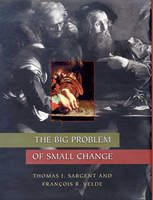By Thomas J. Sargent and
François R. Velde
Princeton University Press
432 pages
Editor's note: The following review originally appeared in the April 2003 issue of the Journal of Political Economy.
Introduction
Throughout the Middle Ages and well into the Renaissance, monetary systems experienced a recurring coinage problem. In systems that had coins with at least some intrinsic value (for example, silver or gold), intermittent shortages of small change occurred. Debasements and an influx of foreign coins often accompanied these shortages.
 Throughout this period, governments struggled to overcome this problem,
but without much success. Carlo Cipolla (Money, Prices, and Civilization
in the Mediterranean World, Fifth to Seventeenth Century, 1956,
p. 31) called the failure of governments to prevent these shortages
"the big problem of small change." Cipolla's observation
provides the motivation (and title) for Thomas J. Sargent and François
R. Velde's book.
Throughout this period, governments struggled to overcome this problem,
but without much success. Carlo Cipolla (Money, Prices, and Civilization
in the Mediterranean World, Fifth to Seventeenth Century, 1956,
p. 31) called the failure of governments to prevent these shortages
"the big problem of small change." Cipolla's observation
provides the motivation (and title) for Thomas J. Sargent and François
R. Velde's book.
The Big Problem of Small Change is an impressive piece of scholarship that should be of interest to most economists, not just to economic historians. It offers a coherent model of money that helps explain a recurring problem that can arise with a commodity money system and that provides the basis for understanding a solution to this problem.
The motivation and the model
The recurring shortages of small change are one part of the motivation for the book. The other is contained in Figure 2.1 (p. 16), which shows the metallic content of small coins for six economic regions over hundreds of years. Each region shows a similar pattern of intermittent debasements, decreases in the amount of metal, of small-denomination silver coins from as far back as 1200 and extending to 1800. Sargent and Velde (p. 15) interpret this as a "pervasive and persistent depreciation of small denomination coins."
What do shortages have to do with depreciations? Or as Sargent and Velde (p. 15) state the question, "How can something in short supply have its price fall over time?" The first part of their book presents a coherent model of money that provides an answer. The fact that small coins are in short supply implies that they are providing a liquidity service that large coins are not. Consequently, when a small-coin shortage occurs, small coins have to depreciate relative to large coins if the public is going to be willing to hold both. This is the key insight in Sargent and Velde's research and underlies much of their analysis.
More explicitly, the Sargent-Velde model is a variation of the conventional cash-in-advance model of money. In it, there are two types of coins of the same metal (say, silver). One contains a small amount; the other, a large amount. Only small-denomination coins can be used in small transactions (what Sargent and Velde call the "penny-in-advance constraint"), but both denominations can be used in large transactions.
Both types of coin are minted freely (in the sense of unlimited, not
necessarily costlessly). The public brings an ounce of metal to be
minted and receives a set number of coins of a given type in return.
The intrinsic value of a coin in terms of goods is its mint
equivalent. The mint equivalent less any government fees (seigniorage
and brassage) is the mint price.
The relationship between the price level (coins per consumption good), the mint price and the mint equivalent determine whether a given coin will be minted or melted. If the price level is less than the mint price, the public has an incentive to turn its silver into coin. If the price level exceeds the mint equivalent, the public has an incentive to melt coins, turning them back into silver. As long as the price level is less than its mint equivalent but greater than its mint price, a given coin will be neither melted nor minted. In effect, each denomination of coin has pairs of "silver points." Sargent and Velde's model highlights the tendency for these silver points to become misaligned as the economy grows or shrinks, creating shortages of some denominations of coins.
The intermittent shortage theorem for small coins follows directly from this model. If income should start increasing, the penny-in-advance constraint can become binding, which is Sargent and Velde's definition of a shortage. A shortage, in turn, implies that the return on small-denomination coins must be less than that on large-denomination coins; that is, the exchange rate of small for large coins must be rising. Otherwise, no one will want to hold the large-denomination coin. And a depreciating exchange rate can lead to a rising price level (assuming that the small-denomination coin is the unit of account). Further, if small coins depreciate to the extent that they become worth more as a commodity than as a money, then they will be melted, aggravating the shortage.
A government can eliminate the small-change shortage by debasing the small coins. Thus, according to Sargent and Velde's model, most debasements were benign governments' cure for this recurring problem, rather than avaricious governments' means to collect seigniorage.
Confronting the data
The first section of the book provides a general overview of the facts motivating the study and the theory that will be used to explain the facts. This is followed by a section of three extensively researched, but loosely connected, chapters. The first, Chapter 4, is a history of the evolution of the minting technologies that eventually mitigated the counterfeiting problem enough to allow for convertible token coins. Chapters 5 and 6 are two engaging chapters that go through hundreds of years of the history of legal and economic thought on the value of metal coins.
In these latter two chapters, Sargent and Velde trace the evolution of the valuation of coins through the Middle Ages in legal contracts. The prevailing view in 1200 was that coins should be valued by their metal content. By 1600 this view had evolved to admit the theoretical and practical possibilities that coins could be valued by tale, that is, simply by count. The distinction is important in Sargent and Velde's theoretical model, which, like other models of Sargent and Smith (Journal of Economic Theory, 1997) and Velde and Weber (Journal of Political Economy, 2000), assumes that coins exchange by tale and above their intrinsic value.
The theory is confronted with the historical evidence in the third section of the book. This section is most impressive because the evidence covers several city-states and countries over a long historical period and consists of data on mint prices, mint equivalents, exchange rates between coins, prices and minting volumes. In general, Sargent and Velde find the evidence to be consistent with the theory.
The section begins with the establishment of the relevant facts: Depreciations, debasements and the influx of foreign coins accompanied intermittent shortages of small-denomination coins. For example, Chapter 8 demonstrates that small-change shortages were recurring in medieval England and France. Here the authors present anecdotal evidence from contemporary writers complaining of shortages. They support this evidence with examples of government interventions that are also evidence of small-change shortages. These examples include restrictions on the import of foreign coins that had lower intrinsic content, prohibitions on the export of domestic small coins, the introduction of new, lower-valued coins (England) and requirements to mint small coins (France). Presumably, a lack of price-level and exchange-rate data prevented Sargent and Velde from using these examples to test their theory.
The next chapters look at the history of coinage in Italy and France to determine if it is consistent with the implications of their model once a shortage occurs. Chapter 9 discusses coinage evidence from Florence roughly over the period from 1250 to 1500. As predicted by the theory, piccioli and quattrini, the small-denomination coins, depreciate against the large-denomination silver and gold coins. The largest part of the chapter is spent discussing the period from 1330 to 1380, which includes the so-called Quattrini affair. This experience generally accords well with the predictions of the model. The price level and the exchange rate move together for most of the period. However, the authors note an exception. The upward movement in prices roughly between 1365 and 1370 precedes the movement of the exchange rate, rather than being coincident with it as the model would predict. Chapter 10 discusses similar evidence for Venice for roughly the same period. As was the case in Florence, the piccioli depreciate against the large-denomination silver and gold coins as predicted by the theory. Unfortunately, the lack of price-level data prevents Sargent and Velde from testing this implication of their theory with data from Venice.
Chapter 11 discusses the shortage evidence for France in the 15th through the 17th centuries. The primary focus is on the 1500s. Extensive evidence on the existence of small-change shortages is presented, and the authors show that small-denomination coins depreciated against large-denomination ones.
A disappointing aspect of this section is that the authors do not make greater use of the minting data they have. Data on mint bounds, prices and minting quantities are presented for both the Quattrini affair (Florence) and France. However, Sargent and Velde make no attempt to see if the minting data conform to the model's prediction that a coin should be minted whenever its mint price equals the price level. At least for Florence, our impression is that this prediction of the model would be borne out by the minting data.
Discovering the standard formula and lessons learned about fiat money
A solution to the small-change problem is the standard formula. It calls for eliminating the free minting of small-denomination coins. In their place, the government issues token coins (small-denomination coins that have little or no intrinsic value) that are convertible into something that has intrinsic value.
Sargent and Velde argue that once their theory is understood, the standard formula solution is obvious. The convertibility of the token coins eliminates the penny-in-advance constraint that is the source of the big problem of small change. However, most countries only adopted the standard formula in the late 1800s after centuries of trial and error.
In the fourth section of the book, Sargent and Velde examine why it took "historical decision makers" so long to discover the standard formula solution. In particular, they investigate whether the delay was caused by the lack of a technology for making token coins that were difficult to counterfeit or whether it was caused by governments having to learn why money is valued. They conclude that both causes played a role in delaying the adoption of the standard formula.
The heart of this section is the chapters that describe several experiments with small change. Sargent and Velde allege that these experiences provided historical decision makers with theory and evidence leading to the standard formula as the solution to the small-change problem.
One of these experiments, described in Chapter 14, is the 17th-century Castilian experiment with inconvertible copper coins. By royal decree in 1596, a limited quantity of new small-denomination, inconvertible, pure copper coins were to be minted to replace the existing partly silver small coins. Sargent and Velde document that for roughly 40 years, this copper coinage circulated above its intrinsic value, that is, by tale rather than by weight. By 1626, so much of this copper coinage had been emitted that all the large-denomination, pure silver coins had been replaced. Sargent and Velde assert that inflation set in at this point. (Strangely, they discuss inflation in terms of the exchange rate between copper and large silver coins, which presumably no longer were around, rather than in terms of the price of consumption goods and copper coins.) After the king abruptly halted the minting of copper coins, the inflation abated. Sargent and Velde argue that this experiment revealed that coins could circulate by tale so that the quantity of money determined the price level and that convertibility was important for implementing the standard formula.
Another of these experiments is the way Britain dealt with small change from the mid-1500s to 1817. At times during this period, the government permitted private laissez-faire provision of copper coins. These coins were convertible. During one of these periods, the private coins solved the small-change shortage to such an extent that Sir Henry Slingsby, master of the London Mint, stated something very close to the standard formula in 1661. Despite Slingsby's statement and the availability of a new technology that would make tokens more difficult to counterfeit, Britain did not adopt the standard formula officially for another 150 years. And that adoption was "accidental," in the sense that it nationalized the private copper coinage system that had been in place since the 1740s. The authors blame the delay on John Locke's argument that all coins should be full-bodied and the fact that a convertibility commitment by the Stuart kings might not have been believed.
As Sargent and Velde document, the discovery and acceptance of the standard formula was anything but linear. Nevertheless, there is no reason to doubt their claim that the benefits of the standard formula were uncovered through these experiments and eventually led to its adoption.
There is reason, however, to question the authors' claim about what
was learned about fiat money. According to Sargent and Velde (p. 330),
"The evolution of monetary doctrines about small change was an
important part of the process by which a managed fiat currency system
came to be understood and implemented." The authors present no
direct evidence that policymakers gleaned such insights from this
history. Instead, their presumption is that since it was learned that
a commodity money could circulate above its intrinsic value, it was
learned that a fiat money (a money that is intrinsically worthless
and irredeemable) could as well. This presumption is not obvious.
Even in the late 1800s to early 1900s, policymakers and leading
academics were still debating whether money's quantity or its intrinsic
value determines its value. [See, for example, the following in the
Journal of Political Economy: H. Parker Willis (1896), J. Laurence
Laughlin (1903) and Spurgeon Bell (1906).] Further, it is not apparent
that the lessons of the Castilian inflation were learned when countries
adopted fiat money systems. As Sargent and Velde (p. 14) themselves
admit, "The twentieth century brought many prolonged inflation
experiments with fiat money."
Concluding comments
Despite our quibbles, The Big Problem of Small Change is a remarkable book. The history of small-change shortages alone should be required reading for monetary economists and economic historians. Furthermore, the authors' use of an economic model to confront the small-change problem should be of interest to the general profession as well as to theorists. For those pursuing future historical research, we think that Sargent and Velde's use of a model to examine a historical puzzle will be a productive methodology for both testing economic theories and understanding economic history.






